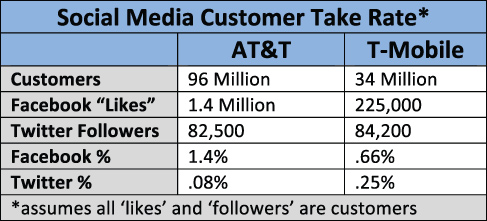|
|

By
Ed Finegold
Social media is the most overhyped thing since Enzyte, but actual business value is hidden behind the veil of pop culture hyperbole. Business use of social media for customer engagement is in a nascent stage. Though adoption amongst wireless operators is widespread, the maturity level remains modest. In light of the news that AT&T will acquire T-Mobile, if the U.S. Department of Justice permits it, we’ve decided to take a close look at what these companies are doing on Facebook, as a small sampling of what’s happening in the social media channel. The activities in which these prospective bedmates have engaged via Facebook are intriguing. What they aren’t doing is surprising. And what customers are saying is often downright hilarious.
Social Media for Customer Interaction
This is all new material, so it makes sense to define some terms. Ultimately, social media channels like Facebook, Twitter, LinkedIn, YouTube
|
|
Anything any company does on Facebook needs to be mobile friendly. |
|


A Facebook-based care operation should
cost exponentially less than a call
center. The more customer service,
technical support, and sales an
operator can manage with its Facebook
presence, the more it will reduce its
fundamental cost of doing business.
Reduced costs equal better margins,
more profitability, happier shareholders
and likely happier customers, given
that effective, online self-service tends
to improve customer satisfaction scores.
Immaturity Abounds
Taking AT&T and T-Mobile as examples,
both operators are essentially using
their Facebook (and Twitter) presences
as proxies for things they otherwise do online, and through both outbound and
|
|
|
|
|

and blogs are all just ways to communicate. Various corporations use these communications methods for different purposes, like tweeting to a specific group about a re-scheduled conference call, or posting on an in-house corporate blog that employees’ health insurance pay-in just jumped up $100 per month. Using social media, however, as a way to engage with, sell to, and care for customers is a different animal and is an increasingly relevant part of customer experience management for communications service providers.
Social media, as a customer interaction
channel, parallels other such channels,
like call centers, online self-service
portals, and retail locations.
|
|

inbound marketing, and via call centers
and retail stores. Keep in mind that
because of how early in its evolution
the practice of social media customer
interaction is, the adoption is still
relatively low (see Table: Social Media
Customer Take Rate), but today’s
practices set the stage for what’s
obviously an area of rapidly increasing
interest.
With both AT&T and T-Mobile, Tweets and Facebook status updates tend to promote new devices and plans; provide tips on using devices or features; and broadcast information about alliance partner marketing. For example, T-Mobile has a section of its Facebook page dedicated to its relationship with the NBA. It promotes its 4G network and displays videos of its TV commercials with Charles Barkley and Dwayne Wade.
article page
| 1
| 2
| 3
| 4
| 5 |
|
|





